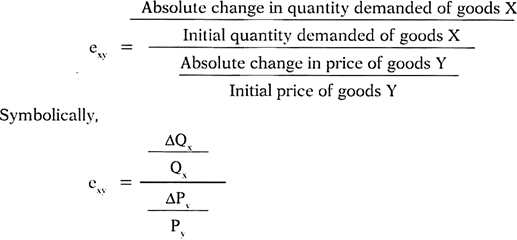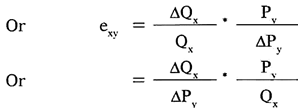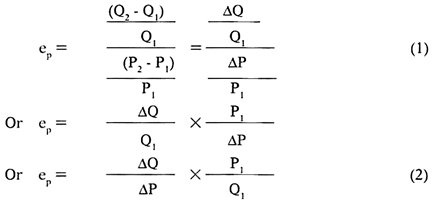In this article we will learn about the Formulas used for estimating the Cross Elasticity of Demand, Income Elasticity of Demand and Price Elasticity of Demand.
Formula Used for Estimating Cross Elasticity of Demand
The measure of cross elasticity of demand provides a numeric value. It is estimated as a ratio of proportionate (or percentage) change in quantity demanded of good X to the proportionate (or percentage) change in the price of the related good Y. That is —
The proportionate change in quantity demanded is estimated as an absolute change in quantity demanded divided by the initial quantity demanded. Similarly, the proportionate change in price is the absolute change in price divided by the initial price. Thus, the above formula can be written as —
Where Qx is the initial quantity demanded of the product X, ΔQx is the absolute change in the quantity demanded of X, Py is the initial price of the product Y and ÄP is the absolute change in the price of Y. The cross elasticity of demand is denoted by exy. The formula can be re-written as —
This formula is used for estimating the cross elasticity of demand. The estimate of elasticity can assume a positive or a negative value depending upon the fact that the two products are substitute or complement to each other respectively.
Formula Used for Estimating Income Elasticity of Demand
Income elasticity of demand is defined as a ratio of percentage change in quantity demanded of a product to a percentage change in the consumer’s income. Mathematically, it is calculated as the proportionate (or percentage) change in quantity demanded of a product divided by the proportionate (or percentage) change in the consumer’s income. That is —
Where Q is the quantity demanded, ΔQ is the absolute change in the quantity demanded, Y is the income of the consumer and the ΔY is the absolute change in the consumer’s income.
Formula Used for Estimating Price Elasticity of Demand
The price elasticity of demand shows responsiveness or sensitiveness of quantity demanded to a change in its own price. It is measured as a ratio of a relative change in demand to the relative change in the price of the product. In other words, it is a ratio between the proportionate (or percentage) change in quantity demanded of a commodity to the corresponding proportionate (or percentage) change in its price. Mathematically, it can be written as —
The percentage change in quantity demanded is estimated as an absolute change in quantity demanded divided by the initial quantity demanded; similarly, the proportionate change in price is the absolute change in price divided by the initial price. Thus, the above formula can be written as —
If the original quantity demanded is denoted by Q1, new quantity demanded by Q2, original price by P1 and the new price by P2, then the above formula can be re-written as —
The above formula (2) is mostly used for estimating price elasticity of demand.






